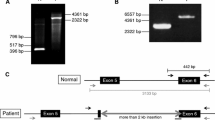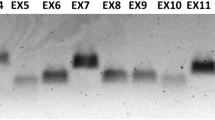Abstract
Short interspersed elements, such as Alu elements, have propagated to more than one million copies in the human genome. They affect the genome in several ways, caused by retrotransposition, recombination between elements, gene conversion, and alterations in gene expression. These events, including novel insertions into active genes, have been associated with a number of human disorders. Hemophilia A is an X-linked severe bleeding disorder and is caused by mutations in the Factor VIII gene. The spectrum of mutations includes point mutations, rearrangements, insertions, and deletions. Recently, an Alu retrotransposition event in a coding exon has been reported in a family with a severe form of hemophilia A. This was the first report of an Alu insertion in the Factor VIII gene. Here, we report a second Alu insertion event that lies in an intron of the same gene that causes exon skipping and the complete disruption of gene expression.


Similar content being viewed by others
References
Antonarakis SE (1998) Molecular genetics of coagulation factor VIII gene and haemophilia A. Haemophilia 4 (Suppl 2):1-11
Antonarakis SE, Kazazian HH, Gitschier J, Hutter P, Moerloose P de, Morris MA (1995a) Molecular etiology of factor VIII deficiency in hemophilia A. Adv Exp Med Biol 386:19–34
Antonarakis SE, Rossiter JP, Young M, Horst J, Moerloose P de, Sommer SS, Ketterling RP, Kazazian HH Jr, Negrier C, Vinciguerra C (1995b) Factor VIII gene inversions in severe hemophilia A: results of an international consortium study. Blood 86:2206–2212
Batzer MA, Deininger PL (2002) Alu repeats and human genomic diversity. Nat Rev Genet 3:370–379
Citron M, Godmilow L, Ganguly T, Ganguly A (2002) High throughput mutation screening of the factor VIII gene (F8C) in hemophilia A: 37 novel mutations and genotype-phenotype correlation. Hum Mutat 20:267–274
Cost GJ, Boeke JD (1998) Targeting of human retrotransposon integration is directed by the specificity of the L1 endonuclease for regions of unusual DNA structure. Biochemistry 37:18081–18093
Ferlini A, Muntoni F (1998) The 5' region of intron 11 of the dystrophin gene contains target sequences for mobile elements and three overlapping ORFs. Biochem Biophys Res Commun 242:401–406
Fujimaru M, Tanaka A, Choeh K, Wakamatsu N, Sakuraba H, Isshiki G (1998) Two mutations remote from an exon/intron junction in the beta-hexosaminidase beta-subunit gene affect 3'-splice site selection and cause Sandhoff disease. Hum Genet 103:462–469
Hagan CR, Rudin CM (2002) Mobile genetic element activation and genotoxic cancer therapy: potential clinical implications. Am J Pharmacogenomics 2:25–35
Jurka J (1993) A new subfamily of recently retroposed human Alu repeats. Nucleic Acids Res 21:2252
Jurka J, Klonowski P (1996) Integration of retroposable elements in mammals: selection of target sites. J Mol Evol 43:685–689
Li X, Scaringe WA, Hill KA, Roberts S, Mengos A, Careri D, Pinto MT, Kasper CK, Sommer SS (2001) Frequency of recent retrotransposition events in the human factor IX gene. Hum Mutat 17:511–519
Liu ML, Nakaya S, Thompson AR (2002) Non-inversion factor VIII mutations in 80 hemophilia A families including 24 with alloimmune responses. Thromb Haemost 87:273–276
Ricci V, Regis S, Di Duca M, Filocamo M (2003) An Alu-mediated rearrangement as cause of exon skipping in Hunter disease. Hum Genet 112:419–425
Roy-Engel AM, Carroll ML, Vogel E, Garber RK, Nguyen SV, Salem AH, Batzer MA, Deininger PL (2001) Alu insertion polymorphisms for the study of human genomic diversity. Genetics 159:279–290
Roy-Engel AM, Salem AH, Oyeniran OO, Deininger L, Hedges DJ, Kilroy GE, Batzer MA, Deininger PL (2002) Active Alu element "A-tails": size does matter. Genome Res 12:1333–1344
Senapathy P, Shapiro MB, Harris NL (1990) Splice junctions, branch point sites, and exons: sequence statistics, identification, and applications to genome project. Methods Enzymol 183:252–278
Shapiro MB, Senapathy P (1987) RNA splice junctions of different classes of eukaryotes: sequence statistics and functional implications in gene expression. Nucleic Acids Res 15:7155–7174
Sukarova E, Dimovski AJ, Tchacarova P, Petkov GH, Efremov GD (2001) An Alu insert as the cause of a severe form of hemophilia A. Acta Haematol 106:126–129
Szmulewicz MN, Novick GE, Herrera RJ (1998) Effects of Alu insertions on gene function. Electrophoresis 19:1260–1264
Vidaud D, Vidaud M, Bahnak BR, Siguret V, Gispert Sanchez S, Laurian Y, Meyer D, Goossens M, Lavergne JM (1993) Haemophilia B due to a de novo insertion of a human-specific Alu subfamily member within the coding region of the factor IX gene. Eur J Hum Genet 1:30–36
Wallace MR, Andersen LB, Saulino AM, Gregory PE, Glover TW, Collins FS (1991) A de novo Alu insertion results in neurofibromatosis type 1. Nature 353:864–866
Windsor S, Taylor SA, Lillicrap D (1994) Multiplex analysis of two intragenic microsatellite repeat polymorphisms in the genetic diagnosis of haemophilia A. Br J Haematol 86:810–815
Wulff K, Gazda H, Schroder W, Robicka-Milewska R, Herrmann FH (2000) Identification of a novel large F9 gene mutation—an insertion of an Alu repeated DNA element in exon e of the factor 9 gene. Hum Mutat 15:299
Acknowledgements
The authors thank the family members of the affected individual for participation in this study. We also acknowledge the generous contribution from Dr. K. Shiomi, Osaka, Japan, which has made this study possible. A special note of thanks is extended to Dr. Tamim Shaikh, Department of Human Genetics, Children's Hospital of Philadelphia for careful reading of the manuscript and valuable suggestions.
Author information
Authors and Affiliations
Corresponding author
Rights and permissions
About this article
Cite this article
Ganguly, A., Dunbar, T., Chen, P. et al. Exon skipping caused by an intronic insertion of a young Alu Yb9 element leads to severe hemophilia A. Hum Genet 113, 348–352 (2003). https://doi.org/10.1007/s00439-003-0986-5
Received:
Accepted:
Published:
Issue Date:
DOI: https://doi.org/10.1007/s00439-003-0986-5




